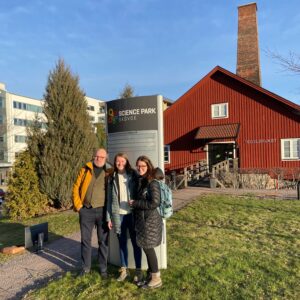Written by Kendra Held
For the month of January 2022, sustainability interns Aviva Meyerhoff and Kendra Held lived and worked with Magnus Fredricson, a Sustainability Strategist at the Skaraborg Association of Municipalities in Sweden. Their goal was to learn more about how innovation systems can drive sustainable development and share their insight with Gustavus, including the Johnson Center for Environmental Innovation.
The Västra-Gӧtaland region, where they lived and worked, is located in the southwestern part of Sweden. West Sweden is globally one of the regions where the most resources (public and private) per capita are spent on promoting innovation. In fact, the region invests more in research and development per capita than Silicon Valley.
There are six main science parks that support research, development, and entrepreneurship located throughout Västra-Gӧtaland. These innovation hubs are made up of academic institutions, business offices, incubation centers and government offices. In this model, the public and private sectors work together to support innovation processes with varying focuses between science parks. For example, the Science Park in the city of Borås focuses on textiles and the circular economy, while the Science Park in Skövde focuses on gaming and digitalization.
During their internship, Held and Meyerhoff were able to interview almost a dozen professionals about their work advancing sustainability initiatives and driving innovation processes. Hearing from regional strategy developers to science park CEOs and regional political leaders, they discovered several takeaways.
In Sweden, as in many countries, academic institutions play a key role in developing sustainable systems and technology in their surrounding communities. This is especially true for science parks in west Sweden. Academic institutions are an integral part of a structure supporting innovative thinkers who develop projects that can become start-ups or are integrated into existing businesses. As mentioned earlier, each of the science parks in western Sweden are place and resource focused, meaning they integrate the areas’ historical and present aptitudes into their specialization. For Gustavus, this might look like exploring southern Minnesota’s agricultural past and present in order to partner with an existing network of businesses and civil servants to draw upon their capabilities. The collaborative aspect between students and professional actors is another lesson that could be applied at Gustavus. Strengthening relationships with local sustainability professionals could expand the impact of the Johnson Center for Environmental Innovation. These are just a few of the ideas that could be applied to Gustavus.
Held and Meyerhoff plan to present their findings and invite audience feedback during a zoom seminar later this spring. Stay tuned for updates!

Leave a Reply